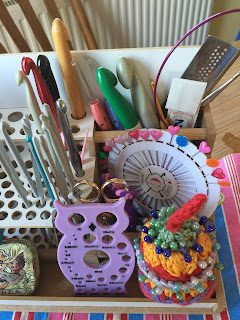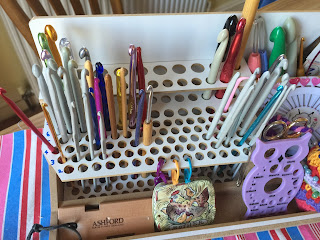Bath University Sampler Aran Throw Crochet-Along SQUARE 11: Berry Bunches.
This is a very pretty square with two bunches of berries defined by vertical tramlines either side and therefore does require a lot of concentration. For ease of working I have drafted a rough diagram but this is to be used for the berries and branches, not so much for the posts/ tramlines as I had not yet decided where they ran when I made the diagram.
The tramlines are worked on both sides in that there's no break they are FPTr on the front side and BPTr on the reverse but the berries are worked on the odd rows for the branches and then the even or reverse side rows for the actual berries ( because they are bobbles) and the rows in between are simply all dc across - except for the tramlines of course as explained above.
Berry branches up close.
The reverse side of this square.
The rough diagram, I hope it helps a bit. The row numbers do not exactly correspond with the pattern written instructions below, USE THE WRITTEN ONES please.
The berrybunches panel is 9 stitches across and starts at stitch 5, there are 4 stitches either side ( these form a repeating border pattern) so unusually this square has only 17 stitches. This is needed to have the central berry sitting in the centre, which requires an odd number of total stitches.
Foundation: ch 17 with 6 mm hook, change to 5 mm hook and ch 1.
Row 1: work 17 dc in 2nd ch from hook to end.
Row 2: ch 1, work 1 dc, next work FPTr round the dc in the row below, dc in next stitch and FPTr round dc in row below for the next stitch, these 4 stitches form the border.
Then work 1dc in each of the next 4 sts, ch 1 and skip the next dc, work 1 dc in each of the next 4 sts and that sets the scene for the berry panel in the middle( 9 sts), then work 1 FPTr round the dc in the row below, 1 dc in next st, 1 FPTr round the dc in the row below and 1 dc in the final stitch, this forms the border on the other side. Row finished.
Row 3( and all odd rows will be the reverse side of the square).
On reverse side the post stitch tramlines of the border will be worked with BPTrs and the bobbles will be worked as per the diagram but for the rest the stitches are all simple dc.
So: row 3: ch1, work 1dc,* 1 BPTr, 1dc, 1 BPTr **, then work 9 dc across, working 1 dc into the central ch space made in row 2, then repeat from * to ** and finish the row with a dc.
Row 4: ch 1, work 1dc, ***1 FPTr, 1dc,1FPTr ****, work 1dc in each of the next 2 sts, then work a DTr into the dc skipped in row 2 ( so the loops lying below the chain made above it in row 2), work a dc in the next stitch, then work a Tr into the same loops used for the DTr just now, work 1 dc into the next st, then work a DTr into those same loops again, finish with 1 dc in each of the final 2 sts of this 9 stitch panel, then repeat from *** to **** and finish the row with a dc.
Row 5 : the two side bobbles are made on this row.
Ch1, work 1dc, repeat from * to ** as in row 3, work 1 dc in next st, work a 4Tr bobble in the next stitch ,1 dc in each of the next 5 sts, work a 4Tr bobble but pickup a thread from the stalk on the front as you do so to make it look connected, then work a dc in the next stitch, for the border repeat from * to ** as in row 3 and finish the row with a dc in the final stitch.
4Tr bobbles are worked as follows: yo and insert hook into selected stitch or loops, yo and pull through the first 2 loops, you now have 2 loops on hook, ( or the equivalent of a half made treble), yo and insert hook into the same stitch yo and pull through first 2 loops as before : you now have 3 loops on hook.
repeat that process twice more until you have 5 loops on hook ( or 4 half made trebles) , yo and pull through all 5 loops tightly: 4 Tr bobble made! It will pop out on the correct side of the square.
Row 6: ch1, work 1dc into the first stitch, repeat from *** to **** in row 4 , then work 1 dc in each of the next 4 sts, work a FPTr round the central stalk in row 4, work 1 dc in each of the next 4 sts and repeat from *** to **** in row 4 and finish with a dc in the final st.
Row 7: ch1, work a dc then repeat from * to ** in row 3 , work 1 dc in each of 4 sts, work a 4Tr bobble in the next ( central) st, work 1 dc in each of the next 4 sts, then repeat from * to ** in row 3 and finish the row with a dc.
That finishes the first berries on stalks panel.
Row 8 and 9 are dc across except for the tramlines so the FPTr and BPTr are maintained in the border stitches only.
row 10- row 15 is the same as row 2 to row 7.
Then row 16 is the same as row 8 but the final row is all dc , 17 sts across with the Tch not counting as a stitch and no post stitches at all.
It may come up slightly small and will need stretching at the blocking stage but it does line up well with the other squares .
This is probably the most complicated square in the set. Enjoy!














































